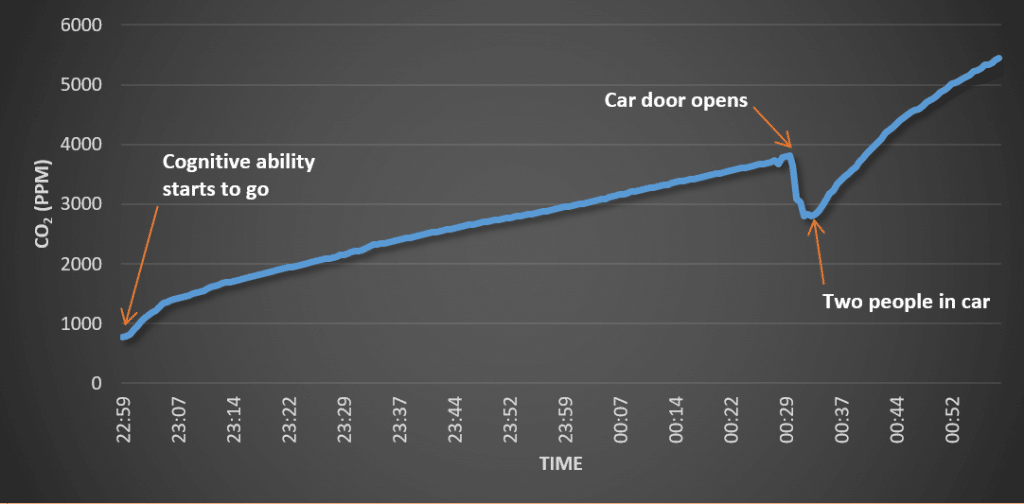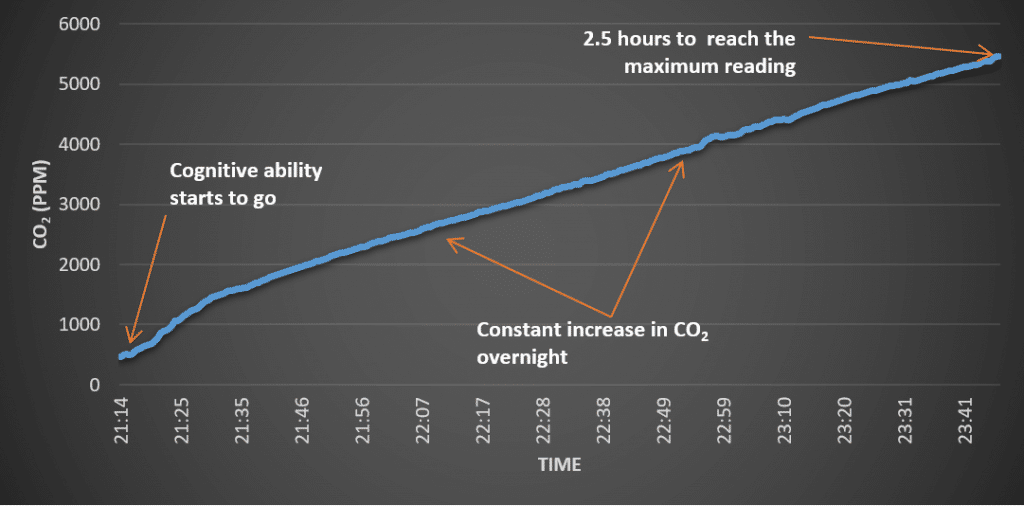Car Air Quality: Risks to Health and How to Improve It
Carbon dioxide over 700ppm (parts per million) can affect your cognitive ability. Sleeping in a car without ventilation creates concentrations of carbon dioxide that can have a detrimental effect on your health (More info on CO2 and cognitive function).
Background on High Carbon Dioxide
High carbon dioxide (CO2) levels may indicate poor air quality and ventilation.
- Outdoor concentrations are around 410ppm. See up to date information on ambient air carbon dioxide concentrations here.
- We can begin to lose cognitive ability above 700ppm; this can also lead to headaches, dizziness and will leave rooms feeling stuffy
- Concentrations of carbon dioxide over 2000 ppm presents a potential risk to health
Vehicles: Who is at Risk?
People who are at risk are people in self-contained vehicles
- Those who sleep in cars, vans or other vehicles
- Caravan, campervan and RV users
- Bus and truck drivers
In addition, levels of both CO2 and particulate are elevated in heavy traffic or tunnels.
Callum’s Science Project
Callum, a nephew of a K2 employee had a school science project. His concern was around rough sleepers in cars. He tested carbon dioxide while sleeping in his family’s car overnight.
- An indoor air quality monitor was in the vehicle with him to monitor CO2 concentrations
- The windows were closed, and the car parked in a garage
- The first night, two people slept in the car
- The second night, he slept in the car by himself

Results of Carbon Dioxide Tests in a Car


What do the results show?
Instrument limitations
- The instrument used only read up to 5,500ppm; the maximum concentration reached is therefore unknown.
- However, it is unlikely to infinitely increase, as an equilibrium between how much CO2 is exhaled and how much fresh air gets inside the car will be achieved (the car is not completely air tight)
- This will cause the CO2 concentration to reach a limit and level out
Some key points shown by the graphs:
- CO2 increased rapidly once the door was shut again during the first night, which suggests another person entering
- Once closed again, the instrument “maxed out” within 30 minutes
- Following this, Callum had a headache the next morning, suggesting that CO2 levels were elevated during the night
- It is expected the concentration would continue to increase throughout the night until it reaches a point of equilibrium
- The second night’s graph, when doors and windows stayed closed shows a very steady trend
- With poor ventilation, levels increased unabated and the instrument “maxed out” in approximately 2.5 hours
- However, no health effects were reported following this night
- The time measured is similar in length to an 8-hour work shift
- Symptoms indicate what a worker may experience when exposed to CO2 levels exceeding workplace exposure standards
Recommendations: How to improve your environmental air quality
Based on this data and other studies, there are several ways to improve vehicle ventilation.
- If sleeping in your vehicle, open windows slightly or leave ajar overnight
- Self-contained vehicles should ideally be fitted with roof vents
- Open windows and doors if cooking inside your vehicle
- Check gas appliances are off if not in use! Carbon monoxide is far more lethal than CO2
- Use electric or oil heaters where possible (e.g. RCD plug on caravans)
- Gas heaters should not be used in enclosed spaces
- Avoid overcrowding your vehicle for both sleeping and driving

Risks when driving
High CO2 levels can make drivers tired and negligent, endangering them and other road users.
- Use your car’s HVAC system or vents in heavy traffic
- Opening windows at these times may expose occupants to exhaust fumes
- Use the fresh air setting, not recirculation for long periods


- Take breaks on long trips, open doors or windows when doing so if you can
- Check your cabin air filters (if fitted) regularly, clean or replace if required
- Avoid high temperature settings which make your car interior feel stuffy
- They also increase respiration and subsequent CO2 exhalation
- NZTA reports hot cab temperatures as a cause of truck driver fatigue
Other risks associated with sleeping in a vehicle
High humidity and low temperatures were recorded while Callum was sleeping in the car.
Temperature
Room temperatures below 16°C increase the likelihood and severity of respiratory infections and other illnesses
- Temperatures were as low as 11°C in the car overnight
- Cars are poorly insulated (metal panels, glass windows)
- Covering windows may help reduce heat loss while sleeping
- Seek alternative accommodation if warm temperatures cannot be maintained
Humidity
Humidity reached 87% during Callum’s project
- High indoor humidity is associated with a number of issues
- It can promote mould growth, which can cause serious health effects
- It can damage building materials and vehicle interiors
- It can also make a room or car harder to heat
- Ensure adequate ventilation and dry out interiors where necessary
- Do not store wet items such as clothing in vehicle cabs

Risks to people living in poverty
- People in these circumstances have been reported sleeping in cars for prolonged periods
- This can make them more vulnerable to serious health problems
Conclusion
- We should primarily reduce the need to travel so much, as this is a major source of air pollution
- If you’re using a vehicle, ventilation (fresh air exchange) is key for reducing CO2 and making for safer driving and trips that are more enjoyable
- It also help reduce other air contaminant concentrations and make for a healthier, cleaner vehicle